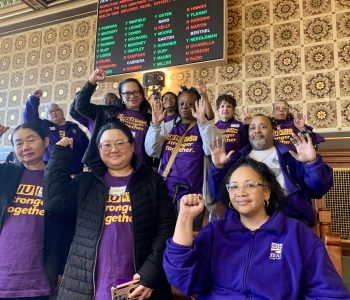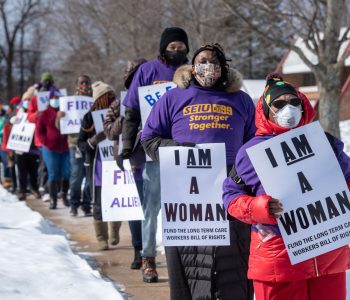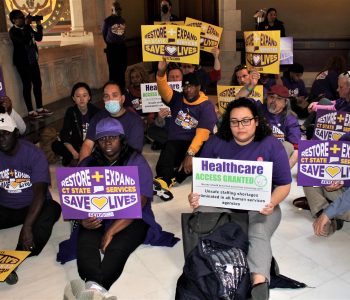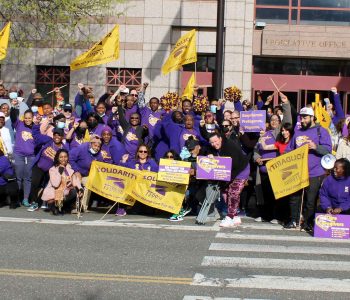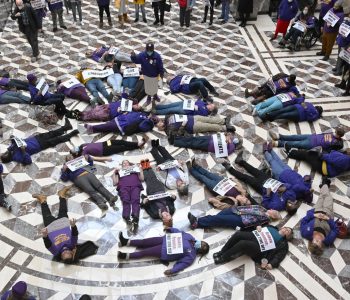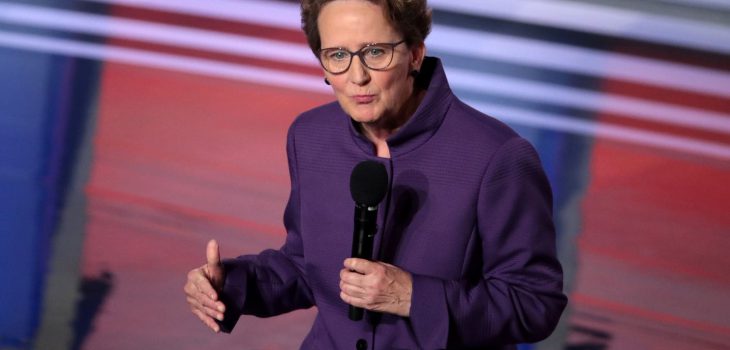 COVID-19
COVID-19
Five months into the pandemic, with another COVID wave looming and the national economy in free fall, Gov. Ned Lamont is socking away Connecticut’s dollars, reminding lawmakers these resources may need to last for many years.
But with more than 4,400 dead from the coronavirus in the state, hundreds of thousands unemployed, an education system mired in uncertainty, and hospitals and municipalities hemorrhaging millions in lost revenues, Connecticut has unprecedented immediate needs.
The next gubernatorial campaign is closer than many realize, too, and Lamont’s critics say saving lives now is more important than keeping taxes down during the next election cycle.
As for tapping the state’s reserve funds – “I would just say it’s much too early,” Lamont said during a briefing last Wednesday. “We have no idea what this economy is going to look like.” One day later, the U.S. Commerce Department announced the national economy had plunged 9.5% during April, May and June, the largest quarterly drop on record. State labor officials say the effective unemployment rate here is about 16%.
And even though Connecticut’s financial reserves are currently plump, analysts warn the state could face annual deficits in excess of $2 billion through 2023, depending on the severity of the national recession.
“We are not out of the woods,” Lamont said before striking a familiar theme: shifting the pressure to Congress. “A lot of this depends upon what we see coming out of the next supplemental from the federal government. We ought to know that in the next few weeks.”
But Rep. Robyn Porter, a New Haven Democrat and leader of the legislature’s Labor Committee, is tired of being told to wait on Washington before using state funds, adding that even if the GOP-controlled U.S. Senate approves more emergency state aid, it likely will be too little.
“Why would you wait?” Porter asked. “If the house is burning down and the fire department isn’t coming, are you not going to go out and try to get some water yourself?”
Porter noted the state’s financial reserves have grown by $300 million since March. Over the same period thousands of nursing home workers became infected and more than a dozen died.
“You don’t get to call them essential workers and then treat them as sacrificial lambs,” she said, adding Connecticut’s reserves could have paid for more testing and protective gear at nursing homes early on in the pandemic, before federal aid arrived.
And if tapping a record-setting $2.8 billion rainy day fund to save lives now means raising taxes in the next gubernatorial election cycle, Connecticut has wealthy families that can afford them, said Rep. Anne Hughes, D-Easton, co-chair of the House Democratic Progressive Caucus.
Hospitals, who estimate they’ve lost $1.4 billion during the pandemic, asked Lamont for $450 million of Connecticut’s federal relief funds. Lamont suggested recently they would receive $100 million.
The nursing home industry says the funds it’s received covered most needs through June, but leaders say another $300 million is necessary to get through this fiscal year. It’s still awaiting word from Lamont.
“It’s kind of negligent,” Hughes said. “Our responses have not been proportional to the threats.”
Today’s budget decisions bear fruit during next gubernatorial race
The next gubernatorial election year, 2022, is 17 months away, but one aspect of the campaign is closer than many realize.
Connecticut budgets on two-year cycles, and the biennial package that runs through Election Day 2022 begins next July. More importantly, Lamont — who hasn’t said whether he will run again — must propose how to balance that budget in February, and his staff must begin drafting that proposal this fall.
If Lamont were to tap the reserves now, and if the deficits projected for this year and the coming biennium remain large — and if Congress doesn’t come through with more aid — he could face the unpleasant task of raising income taxes and cutting programs while asking voters for four more years.
On the other hand, if he refuses to spend Connecticut’s reserves, if new reports of surging revenues soften the deficits and if Congress grants states another round of relief, the governor could have a much smoother fiscal path on which to campaign.
The only catch with waiting to see what happens, critics say, is that people will continue to become sick, die or otherwise suffer in the meantime.
State legislators enacted a sweeping police accountability reform bill in special session in late July. But many members of the Black and Puerto Rican Caucus wanted a broader reform package that addressed inequalities in housing, education, health care and economic opportunity.

That’s because the coronavirus has only exacerbated the extremes of inequality in Connecticut, Porter said. Disproportionate numbers of Black and Latino residents have become infected or died or suffered other hardships since the pandemic began.
“You can legislate change on how to police, but until you change the conditions under which people exist, the job is not finished,” she added. “The problem is we don’t have the political will to get it done. … We’ve got to stop saying, ‘We don’t have the money.’”
Lamont, a wealthy Greenwich businessman, has been at odds with much of his Democratic base on fiscal matters throughout his tenure, insisting that taxing rich residents would prompt them to flee Connecticut.
“They’re fleeing into our arms,” Hughes said, referring to recent reports that New York metro area residents increasingly are moving into Connecticut, drawn by its lower COVID-19 infection rates. “They’re fleeing into my district and they’re not asking if they’re going to have to pay a little more [of their] wealth.”
Taking pandemic relief back from nonprofits
Critics charge the administration is trying to cover too many needs with only federal dollars while holding Connecticut’s billions in reserve.
Nowhere is that more evident, they say, than with the hundreds of private, nonprofit agencies that deliver most state-sponsored social services to the disabled and people with mentally illness.
Connecticut spends about $1.4 billion annually on these community-based programs, a sum that hasn’t changed much in two decades. The industry pegs the inflationary loss it’s taking on these payments at $460 million per year.
After waiting more than two months for relief, nonprofits got a share of the $350 million also spread among state agencies, municipalities, hospitals and nursing homes to fund testing and protective gear costs.
But on July 20, the Lamont administration notified community groups that work with the developmentally disabled that, if they received a Pandemic Payroll Protection [PPP] loan from the federal government, then they would have to return the federal coronavirus relief grant they received via the state. The governor’s budget office later clarified nonprofits would have to return grant funds if they were used to pay for an expense also covered with a PPP loan.
Gian-Carl Casa, president and CEO of the CT Community Nonprofit Alliance, said the two forms of assistance aren’t remotely related.
The federal loan “was designed to keep people employed. Most of it is tied to salary and benefits,” he said.
Nonprofits couldn’t use those funds to cover the protective gear, testing and other safety measures funded with the aid the state now wants back.
Horizons, a South Windham-based nonprofit that runs a wide array of services for the developmentally disabled, already was projecting a $734,000 shortfall this fiscal year with services running at 20% capacity — before the administration indicated it wanted to claw back about $350,000 in relief funds.

Chris McNaboe, 68, who founded Horizons 41 years ago, is uncertain of its future. The administration directed Horizons to 4-CT, the COVID charity formed by private philanthropic foundations in April at Lamont’s urging.
But officials at 4-CT “said we were not a good fit for what they were looking for,” McNaboe said, calling that surprising since Horizon’s respite camp alone serves more than 1,700 clients, drawing them from virtually every community in Connecticut. “They said they were looking for larger initiatives that were really statewide,” she added.
Ted Yang, 4-CT’s CEO and co-founder, declined to comment.
Lamont, who has repeatedly rejected nonprofits’ funding appeals over the past year, instead has increasingly steered them toward philanthropy.
Nonprofits, who typically draw 85% or more of their funding from government sources, say Lamont doesn’t understand their fiscal reality: small agencies that serve the intellectually disabled, and people struggling with mental illness or drug addiction, aren’t popular targets for philanthropy.
And while many nonprofits and their services face severe financial peril, Casa said some of the damage can’t be measured in dollars.

Doree Levy, 73, of Westport, has been sending her daughter, Ariel, to Horizons for the past 20 years. “My biggest fear is that these programs will close,” Doree said. “That would just be the end of something beautiful.”
Despite having cerebral palsy that makes daily tasks and walking difficult, Ariel, 36, is very social, her mother said. Horizons has led to lasting friendships as well as opportunities to enjoy music, dance, cooking and volunteer work.
Horizons isn’t offering overnight services during the pandemic, and Ariel’s elderly parents can’t make the 90-minute drive daily from Westport to Windham. “It’s heartbreaking to watch and heartbreaking to try to explain this thing,” Doree said. “Her life has come basically to a standstill.”

Lamont has been saving during the pandemic
But while healthcare and social services ran into financial jeopardy over the past four months, the state’s coffers have swollen.
Connecticut had $2.5 billion in the bank, a reserve equal to 13% of annual operating costs, when the pandemic struck.
Lamont pushed the traditional April 15 income tax filing deadline back three months to assist troubled households – a move that might have hurt incoming revenue. But a preliminary analysis of summer filings led state analysts to bump revenue projections by $200 million for the fiscal year that ended June 30, and another $50 million for 2020-21.
Connecticut’s income tax is among the most volatile of any state’s. And quarterly tax filings, which are tied heavily to capital gains, often surge just before an economic downturn, as investors sell their stocks.
But the administration also pumped up reserves by not spending $544 million last fiscal year — two-and-a-half times the savings target mandated by the legislature to balance a $19.3 billion General Fund.
Lamont’s budget director, Office of Policy and Management Secretary Melissa McCaw, said much of that savings was driven by the pandemic. Emergency federal Medicaid assistance meant fewer state dollars were needed for healthcare programs. And with more employees telecommuting, many state buildings were closed.
Additionally, McCaw added, those savings couldn’t be repurposed without the approval of legislators — who effectively adjourned in mid-March in response to the pandemic.
The Senate chair of the legislature’s Appropriations Committee, Sen. Cathy Osten, D-Sprague, said her panel wanted to craft budget revisions, but has been struggling all summer to get the answers it needs from the Lamont administration.
“There is no interest in talking with us on how the money is being spent,” said Rep. Toni Walker, D-New Haven, the committee’s House chairwoman. “We would love to have that conversation with them.”
Committee members also have been interviewing Lamont’s department heads via teleconference, pressing for details on why so much funding went unspent.
“We’ve asked repeatedly for meetings with the OPM secretary,” Osten said, adding her panel still needs details both on agency spending and federal relief funds. “We need to talk about all of that.”
Lamont defended his budget chief.
“Melissa McCaw, talk about talent, has a pretty sharp pencil,” the governor said. “And she’s really held the line on spending.”
The $1.38 billion Coronavirus Relief Fund grant Connecticut received from Washington, though appreciated, falls short of the state’s needs, McCaw said. And Connecticut still has to find funds to assist with the reopening of schools and child care facilities this fall, and to bolster job retraining. That means few groups will get everything they want, McCaw said.
Connecticut’s cities and towns didn’t come close.
Federal guidelines recommended states share 45% of their Coronavirus Relief Fund grants with municipalities. That would have meant about $600 million out of Connecticut’s $1.38 billion federal grant. The Lamont administration awarded $75 million, a little more than 5%, prompting fears the pandemic could force local tax hikes and make a highly regressive municipal tax system even worse.
Federal funds must be used to cover direct COVID-related costs, but the state could use its reserves to replenish some of the $400 million in revenue deferrals and losses municipalities have reported to date.
“Do we really want to get through the coronavirus with increased property taxes?” asked Joe DeLong, executive director of the Connecticut Conference of Municipalities. Is that the goal here, to put the pressure on the property taxpayer?
Business leader: Lamont is smart to save
Joseph F. Brennan, who retired last week after leading the Connecticut Business and Industry Association for 32 years, praised Lamont for not cracking open the state’s piggy bank to supplement federal aid.
“The pandemic has showed us just how vital the private sector is,” Brennan said. “People are struggling because businesses aren’t operating at full capacity. There’s nothing that pays for state programs like a thriving economy.”
Any significant tax hike in the next state budget would be a death blow to a Connecticut economy that already is reeling from thousands of businesses either closed or operating at reduced capacity, and hundreds of thousands of people unemployed, he said.
“You want to be welcoming to people, not turning them away,” Brennan said.
“Governor Lamont has been clear and consistent throughout his administration that he does not want to increase major tax rates in such a way that would destabilize our delicate economy — especially during this pandemic-related economic downturn,” McCaw said.
Connecticut lagged the nation in its recovery from The Great Recession of 2007-09, but it has contained the spread of the coronavirus much more effectively than have other states, Brennan said.
“COVID has leveled the playing field,” he said. “So why not capitalize on that?”
But Sal Luciano, head of the Connecticut AFL-CIO, said not all aspects of the economy are sputtering.
The Dow Jones Industrial Average has nearly recovered all the value it lost after March 1. But over the same period, nearly 40% of the households nationally that earn less than $40,000 per year had lost at least one job by May. And many of the jobs Connecticut added during the last decade involve low-paying, retail and other service positions.
“The pain wasn’t shared equally,” said Luciano, who also called for Connecticut to use its resources to supplement federal aid. “While poor people suffered and other people suffered, the rich were doing quite well during this coronavirus pandemic — including not having to put their lives at risk.”


